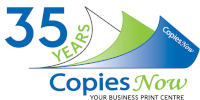File Formats
Everything you need to know about your files for printing with CopiesNow.
Standard Print File Types:
PDF
Adobe Acrobat PDF files are viewable and printable on virtually any platform, including Windows®, Mac OS, and smart phones. It is the global standard for capturing and reviewing information from almost any application on any computer system and sharing it with virtually anyone, anywhere. PDF files are generally not editable.
MS OFFICE Files (DOC, PUB, XLS)
Files such as these are used for producing anything from professional documents and posters to spreadsheets. You must have these applications on your device in order to view or edit these files. Documents created in these programs can be saved or exported as PDF files which helps insure their stability with emailing of transferring them to another computer.
Standard Design File Types:
AI
Stands for Adobe Illustrator. Fully editable stationery design master file. Professional logo designers use vector drawing tools like Adobe Illustrator to create logo designs.
PSD
Refers to Photoshop Document. These files are created in Adobe Photoshop, usually by professional designers. They may be created in CMYK or RGB color make-up, with layers, and then saved out as many different formats (i.e. TIFF, JPEG, PSD, PDF, etc.) and at different levels of resolution. In order for us to edit these files, we require the raw PSD file with all of its layers.
INDD
Indesign files. Indesign is the graphic design program which works as a part of the Creative Suite of programs consisting of Indesign, Photoshop and Illustrator. They are created by Adobe and are highly compatible with one another to provide printers with a powerful way of producing graphic designs and page layouts.
JPG/JPEG
Files come in 3 sizes = Large, Medium and Small. Files can be saved at various different resolutions or dpi, and in either grayscale, CMYK or RBG color make-ups. This is one of the most common files types and can be used for home/office printing applications such as Word or Power Point, and also for web design. In order for a JPEG file to print clearly, it needs to be at a minimum of 300 dpi, JPEG files copied off the internet or websites are unacceptable both in resolution size and because of copyright restrictions.
TIFF
Stands for Tagged Image File Format developed early on in the desk-top computer printing age. It is commonly used for transporting color or grayscale images into page layout applications, but less suited for web content. These files are usually large and of high quality (300 dpi for greater).
EPS
This is a fully editable file that all the other file types are created from. These files may be VECTORIZED, which means ithey are made in a vector-rendering program such as Adobe Illustrator, Freehand or Corel-Draw. Vector graphics rely on a set of paths to determine the outline of an image. Vector files are created by graphic designers so that logos and other images can be easily converted to a wide range of sizes without distorting the image.
RESOLUTION or DPI (Dots Per Inch)
All computers printing is created and made up of hundreds or very small dots (viewable under a microscope). The more dots per inch or the higher the resolution, the better quality of viewing or printing you get. Printers normally require a minimum of 300 dpi for graphics.
CMYK (Cyan Magenta Yellow Black)
These are the four basic colors which are used in various amounts to create different colors. As you may remember from elementary school, pink and yellow make red, blue and yellow make green. By using these four colours in various percentages, you can create virtually every color in the rainbow.


